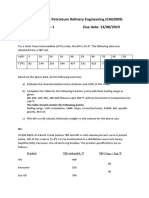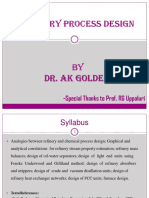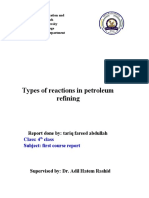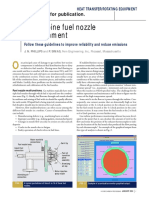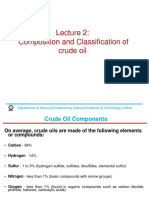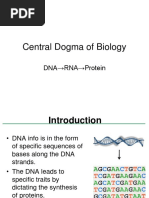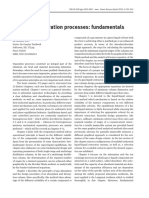Evaluation of Crude Oil: Department of Chemical Engineering, National Institute of Technology, Calicut
Uploaded by
john paul.jaisonEvaluation of Crude Oil: Department of Chemical Engineering, National Institute of Technology, Calicut
Uploaded by
john paul.jaisonLecture 3:
Evaluation of crude oil
Department of Chemical Engineering, National Institute of Technology, Calicut
Evaluation of Crude oil
Evaluation of crude oil is important for refiner because it gives the following types of
information:
1. Base and general properties of the crude oil.
2. Presence of impurities such as sulfur, salt, and emulsions which cause general
difficulties in processing.
3. Operating or design data. Primarily this necessitates curves of temperature and
gravity vs. per cent distilled.
a. Fractionating or true boiling point distillation curve.
b. Equilibrium or flash-vaporization curve.
c. API or specific gravity curve of each fraction distilled.
4. Curves of the properties of the fractions vs. percent distilled (mid per cent
curves) or the average properties of a series of fractions vs. Percentage
yield (yield curve) by which common realization of yields can be prepared.
Department of Chemical Engineering, National Institute of Technology, Calicut
Types of Distillation Curve: Crude Oil
1- True Boiling point (TBP) Distillation.
2- ASTM Distillation.
3- Equilibrium Flash Vaporization (EFV).
Department of Chemical Engineering, National Institute of Technology, Calicut
True Boiling point (TBP) Distillation
• firstly, under
atmospheric pressure
until 300°C (1%
distilled very 2 min)
• secondly under
vacuum pressure (to
prevent cracking
process and to
reduce the boiling
point) at 40mmHg (1%
distilled every 3-5
min)
• the vapor press.
temp. is plotted vs.
distilled(%) to get TBP
curve
Department of Chemical Engineering, National Institute of Technology, Calicut
ASTM Distillation
• It is a simple distillation
carried out with standard
ASTM flasks 100,200,500 ml
flasks.
• The data obtained is similar
to TBP data.
• No reflux is provided.
• Rapid batch distillation
employing no trays or reflux
between the still pot and
condensation
Department of Chemical Engineering, National Institute of Technology, Calicut
ASTM Distillation
• ASTM method D86 (atm. Press.): Gasoline, Kerosene, gas oil and
similar light and middle distillates.
• ASTM method D1160 (max. temp. 400oC, min.1mmHg): For heavy
petroleum fractions which tend to decompose at atm pressure
Department of Chemical Engineering, National Institute of Technology, Calicut
ASTM and TBM Distillation
• TBP/ASTM distillation curves: are the most important characterization
properties of the crude/intermediate/product streams.
• Both TBP, ASTM distillation curves are measured at 1 atm pressure.
• In both these cases, the boiling points of various volume fractions are
being measured.
• TBP curve is measured using batch distillation apparatus consisting with
15 stages and reflux ratio of 5.
• ASTM Curve: is more common because it is simple to determine in the
laboratory.
• TBP Curve: is the most useful.
• the ASTM distillation is measured in a single stage apparatus without any
reflux.
Department of Chemical Engineering, National Institute of Technology, Calicut
ASTM and TBM Distillation
Riazi and Daubert (1980)
Department of Chemical Engineering, National Institute of Technology, Calicut
Equilibrium or Flash Vaporization (EFV) Distillation
Department of Chemical Engineering, National Institute of Technology, Calicut
Cut points
TBP cut points for crude oil distillate fractions
Distillate Product Boiling Range
Butanes and Lighter
o o
Light SR Naphtha 90 - 190 F (32-88 C)
o o
Heavy Naphtha 190 - 380 F (88 - 193 C)
o o
Kerosene 380 - 520 F (193 - 271 C)
o o
Light Gas Oil 520 - 610 F (271 - 321 C)
o o
Heavy Gas Oil 610 - 800 F (321 - 425 C)
o o
Light Vacuum Gas Oil 800 - 950 F (425 - 510 C)
o o
Heavy Vacuum Gas Oil 950 - 1050 F (510 - 564 C)
o o
Vacuum Residue > 1050 F (>565 C)
Department of Chemical Engineering, National Institute of Technology, Calicut
Department of Chemical Engineering, National Institute of Technology, Calicut
Crude distillation curve
Department of Chemical Engineering, National Institute of Technology, Calicut
Gravity-mid-percent curves
• The properties are found to be different
for each drop or fraction of the material
distilled.
• The rate at which these properties
change from drop to drop may plot as
mid per cent curves.
• the specific gravity or viscosity of a
fraction is an average of the properties
of the many drops that constitute the
fraction.
• the average property is equal to the
property at the mid-point of the fraction.
Department of Chemical Engineering, National Institute of Technology, Calicut
True boiling point (TBP)
Physical property for which it is
Average Boiling Point
distinct.
Used for liquid viscosity, Specific
Volume Average
gravity.
Weight Average Critical properties i.e., temperature
Characterization factor, Thermal
Molal Average
Expansion of liquid.
Molecular weight, Sp. gravity, Heat of
Mean Average
combustion, Sp. heat etc.
For additive properties, viscosities are
Cubic Average additive when expressed on cubic
average.
Note: For narrow boiling cuts (TBP slope less than 2) all above mentioned
boiling points tend to equal.
Department of Chemical Engineering, National Institute of Technology, Calicut
True boiling point (TBP)
1:Vol. Avg. - Based on the boiling temperature of different
cuts (VABP)
Used for distinguishing physical property like Liquid Viscosity,
Specific Gravity.
For short cut Boiling Point (having short B.P), VABP =T50%
Department of Chemical Engineering, National Institute of Technology, Calicut
True boiling point (TBP)
2. Weight Average Boiling point- For Critical Temperature.
% calculation based on weight.
(Characterization factor, Thermal expansion of liquid, based
upon boiling temperature at different mole fraction.)
3. Molal average
t1, t2, t3 are at respective mole fraction. X1, X2, X3 are mole fraction
Department of Chemical Engineering, National Institute of Technology, Calicut
True boiling point (TBP)
Mean Average Boiling Point
(For Estimating Mol.wt, Sp. Gravity, Sp.heat of fraction.)
Mean Avg B.P=(Molal avg. B.P + Cubic avg. B.P)/2
Cubic avg. B.P
Va= Vol. Fraction
Department of Chemical Engineering, National Institute of Technology, Calicut
Average Boiling Point for a Fraction (summary)
Volume average boling point
Mass average boiling point
Molar average boiling point
Cubic average boiling point
Mean average boiling point
Interconversion of Boiling points
• Calculate slope of distillation curve of a fraction.
• The methods for finding the slope for ASTM/TBP/EFV is same
• TBP Slope = (t70%– t10%)/60 where 70% and 10% are volumetric boiling points.
Department of Chemical Engineering, National Institute of Technology, Calicut
Molal Avg BP
Department of Chemical Engineering, National Institute of Technology, Calicut
Mean AVG BP
Department of Chemical Engineering, National Institute of Technology, Calicut
Conversion of TBP slope to ASTM on
EFV slope
Department of Chemical Engineering, National Institute of Technology, Calicut
Conversion of TBP slope to ASTM on
EFV slope
Department of Chemical Engineering, National Institute of Technology, Calicut
Relationship between ASTM and TBP 50 volume points
Department of Chemical Engineering, National Institute of Technology, Calicut
Crude oil properties
These are required for estimating property of cut ranges in the manual method.
Mid percent API Gravity (density ) is drawn along with TBP
Mid percent Mol. Wt. is drawn along with TBP
Evaluation of crude properties
Calculate Mean average boiling point from TBP slope and correction factor (From
graph)
MABP = VABP- Correction factor
Calculate Characterisation factor (Kw) and API gravity for fractions.
Kw is assumed constant for whole crude and its fraction.
50% BOILING POINTS OF ASTM : Calculated from the slope of TBP Curve of a
crude and its 50% B.P.
Department of Chemical Engineering, National Institute of Technology, Calicut
Estimation of EFV Distillation Curve
Estimation of the straight line EFV curve:
1. Estimate of t 50% of ASTM/ TBP using:
Estimate the 10 to 70% slope of ASTM/TBP using
TBP Slope = (t70%– t10%)/60
Use Fig. to convert slope (ASTM/TBP) to slope of EFV
2. Estimate t 50% of EFV from Fig.
t 50%EVF= t50% TBP− ΔT
3. Draw a straight line through t50% EFV with slop of EFV
4. t 0% ( bubble point )=t 50% EFV – slope FVE*(50)
5 . t 100% (dew point)= t 50% of EFV +slope EFV*(50)
Department of Chemical Engineering, National Institute of Technology, Calicut
Example
Whole crude oil TBT data (API gravity 36.3)
Vol.% 5 10 20 30 40 50 60 70 80 85
TBP 62 144 255 344 437 531 623 717 819 897
Temp (F)
• SP.Gr.For whole crude = 141.5/ (131.5+ API)
• Sp. Gr. = 0.84 (for the crude oil)
• Volume average boiling point VABP for whole crude = (t20+t50 + t 80)/3
VABP =[ ( 255+ 531+819)/3 ]= 535 oF
• TBP Slope =[ (t70- t10)/ 60 ] = (717-144)/60 = [9.6 oF/%]
• Correction Factor (from graph ) = 70 oF
• Mean Average Boiling Point ( MABP) = 535 - 70 = 465 oF
• ΔT = 66oF using t50 TBT
• t 50%EVF= t50% TBP− ΔT =531-66= 465oF
• The slope of EFVC= 6.5oF
Department of Chemical Engineering, National Institute of Technology, Calicut
Example
Department of Chemical Engineering, National Institute of Technology, Calicut
Example
Department of Chemical Engineering, National Institute of Technology, Calicut
Pseudo-Components
• The petroleum fractions - as a mixture of discrete pseudo-components
with defined boiling point ranges or cut points on the TBP distillation
curve.
• Each pseudo-component corresponds to several unknown actual
compounds (e.g. paraffins, naphthenes and aromatics) which boil in a
given temperature range.
• Usually each pseudo-component - an average normal boiling point,
specific gravity and molecular weight.
• The number of such pseudo-components depends on the boiling point
range of the whole petroleum fraction.
• This number is a trade off between producing a smooth calculated
property curve and having too many components which both leads to
excessive computation time
Department of Chemical Engineering, National Institute of Technology, Calicut
Pseudo-Components
The following cut-point ranges are reasonable for most refining calculations
A general guideline for determining the number of pseudo-components is
as follows
Department of Chemical Engineering, National Institute of Technology, Calicut
Pseudo-Components
Department of Chemical Engineering, National Institute of Technology, Calicut
Example
Compute the specific gravity of a 41.4 API (0.8183 spg) mixed base
crude oil from the spg mid percent
Department of Chemical Engineering, National Institute of Technology, Calicut
Example
Department of Chemical Engineering, National Institute of Technology, Calicut
Pseudo-Components: problem
A petroleum cut has the following ASTM D86 Distillation data:
Divide the TBP curve of the petroleum cut into 20 pseudo-components. Calculate
the liquid volume percentage of each pseudo-component
Department of Chemical Engineering, National Institute of Technology, Calicut
Pseudo-Components
• The end boiling point (EBP) of the cut is 218.2°C
• The Initial boiling point (IBP) is -5.4°C
• No of cuts =20
• Temperature interval for each pseudo-component =(218.2+5.4)/20 = 11.2°C
• The EBP of the first cut = IBP+Interval = -5.4+11.2 = 5.8°C
• The average boiling point (NBP) of first component = (IBP+EBP) /2 = (-
5.4+5.8)/ 2=0.2°C
• The volume % at the end of first cut = 2.84 ( from TBP curve)
• The EBP of the second cut= 5.8+11.2 = 17°C
• The average boiling point (NBP) of second component = (5.8+17)/2 = 11.4°C
• The volume % at the end of second cut = 6.19 ( from TBP curve)
• Cut volume for second cut = 6.19-2.84= 3.35
Department of Chemical Engineering, National Institute of Technology, Calicut
Pseudo-Components
Department of Chemical Engineering, National Institute of Technology, Calicut
Homework
Department of Chemical Engineering, National Institute of Technology, Calicut
Homework
For a given crude oil;
1- Draw a TBP curve,
2- Evaluate the crude,
3- Find the value of Kw if API=43,
4- Draw a EFV on the same Figure,
Department of Chemical Engineering, National Institute of Technology, Calicut
You might also like
- CHEN64341 Energy Systems Coursework Andrew Stefanus 10149409100% (1)CHEN64341 Energy Systems Coursework Andrew Stefanus 1014940912 pages
- Characterization Factors: Evaluation of Oil StockNo ratings yetCharacterization Factors: Evaluation of Oil Stock65 pages
- CHE 331: Petroleum Refinery Engineering: Refining: Technology and EconomicsNo ratings yetCHE 331: Petroleum Refinery Engineering: Refining: Technology and Economics101 pages
- Process Dynamics & Control: Muhammad Rashed JavedNo ratings yetProcess Dynamics & Control: Muhammad Rashed Javed33 pages
- Experiment No:1: Determination of Reid Vapour Pressure AimNo ratings yetExperiment No:1: Determination of Reid Vapour Pressure Aim26 pages
- Petroleum Testing Laboratory Manual With CalculationNo ratings yetPetroleum Testing Laboratory Manual With Calculation17 pages
- Production of Synthesis Gas: Caalysis Today, 18 (1993) 305-324No ratings yetProduction of Synthesis Gas: Caalysis Today, 18 (1993) 305-32420 pages
- ASTM Distillation Curve Dr. Khalid FarhodNo ratings yetASTM Distillation Curve Dr. Khalid Farhod13 pages
- Material and Balance For Sohio Process That Produce Acrytonitrile0% (2)Material and Balance For Sohio Process That Produce Acrytonitrile2 pages
- Kerosene Isosiv Process For Production of Normal Paraffins: Stephen W. SohnNo ratings yetKerosene Isosiv Process For Production of Normal Paraffins: Stephen W. Sohn6 pages
- 2 - Properties of Oil and Natural Gas - 2007 - Petroleum Production EngineeringNo ratings yet2 - Properties of Oil and Natural Gas - 2007 - Petroleum Production Engineering9 pages
- Technical Support Section in The Preface To This ManualNo ratings yetTechnical Support Section in The Preface To This Manual19 pages
- Analysis of Temperature Control of CSTR Using S FunctionNo ratings yetAnalysis of Temperature Control of CSTR Using S Function4 pages
- Absorption and Stripping of Dilute MixturesNo ratings yetAbsorption and Stripping of Dilute Mixtures16 pages
- 1 - CL619 RPD - Properties Calculation PDFNo ratings yet1 - CL619 RPD - Properties Calculation PDF166 pages
- Types of Reactions in Petroleum Refining NewNo ratings yetTypes of Reactions in Petroleum Refining New15 pages
- Comparison of Gas Absorption and Distillation Unit Operations100% (2)Comparison of Gas Absorption and Distillation Unit Operations2 pages
- Chapter 3 - Stage and Continuous Gas-Liquid Separation Processes0% (1)Chapter 3 - Stage and Continuous Gas-Liquid Separation Processes46 pages
- Presentation Lecture Slides Petroleum Refinery Engineering100% (1)Presentation Lecture Slides Petroleum Refinery Engineering49 pages
- Fluid Coking: A Power Point Presentation OnNo ratings yetFluid Coking: A Power Point Presentation On15 pages
- 2017.08.28 - Gas - Liquid Contacting Equipments PDFNo ratings yet2017.08.28 - Gas - Liquid Contacting Equipments PDF37 pages
- Nptel Chemical Engineering Petroleum Refinery Engineering9No ratings yetNptel Chemical Engineering Petroleum Refinery Engineering96 pages
- Origin of Life - Final - Oparin-Haldane HypothesisNo ratings yetOrigin of Life - Final - Oparin-Haldane Hypothesis17 pages
- Composition and Classification of Crude OilNo ratings yetComposition and Classification of Crude Oil31 pages
- Central Dogma of Biology: DNA RNA ProteinNo ratings yetCentral Dogma of Biology: DNA RNA Protein20 pages
- Petroleum Refining Operations and ProcessingNo ratings yetPetroleum Refining Operations and Processing25 pages
- Sismat Combined Pretreatment Unit SKP Brochure A4 SpreadsNo ratings yetSismat Combined Pretreatment Unit SKP Brochure A4 Spreads5 pages
- Slurry Questionnaire: Contact InformationNo ratings yetSlurry Questionnaire: Contact Information1 page
- Grundfos PACO All Products Sales Brochure LPPSL001 - 06 - 09No ratings yetGrundfos PACO All Products Sales Brochure LPPSL001 - 06 - 0912 pages
- hydraulic-surge-analysis-in-a-pipeline-network-using-pipelinestudio-en-5396680No ratings yethydraulic-surge-analysis-in-a-pipeline-network-using-pipelinestudio-en-539668010 pages
- PTC A, B1.1 & B2 Basic Notes - Sub Module 8.2 (Aerodynamics)No ratings yetPTC A, B1.1 & B2 Basic Notes - Sub Module 8.2 (Aerodynamics)56 pages
- uPVC Ball Valves: For Water Supply and Irrigation Application..No ratings yetuPVC Ball Valves: For Water Supply and Irrigation Application..2 pages
- V-00-ECI-MECH-0000-OPERATIONAL TEST FOR SANITARY FIXTURE HAND SHOWERNo ratings yetV-00-ECI-MECH-0000-OPERATIONAL TEST FOR SANITARY FIXTURE HAND SHOWER7 pages
- 200rb Solenoid-Valves-Catalog-En-Us-4763170No ratings yet200rb Solenoid-Valves-Catalog-En-Us-47631704 pages
- COACHING NOTES PIPE Elements 1 125 SlidesNo ratings yetCOACHING NOTES PIPE Elements 1 125 Slides125 pages
- Self-Sustained Shock Oscillations On Airfoils at TransonicspeedsNo ratings yetSelf-Sustained Shock Oscillations On Airfoils at Transonicspeeds50 pages
- L-0288 - CS Pipe Wall Thickness Calculation - Rev.1No ratings yetL-0288 - CS Pipe Wall Thickness Calculation - Rev.116 pages
- Vacuum Pumps - Calculating Flow Rate and Required Evacuation TimeNo ratings yetVacuum Pumps - Calculating Flow Rate and Required Evacuation Time3 pages
- Industrial Separation Processes: Fundamentals: Book ReviewNo ratings yetIndustrial Separation Processes: Fundamentals: Book Review2 pages
- CHEN64341 Energy Systems Coursework Andrew Stefanus 10149409CHEN64341 Energy Systems Coursework Andrew Stefanus 10149409
- CHE 331: Petroleum Refinery Engineering: Refining: Technology and EconomicsCHE 331: Petroleum Refinery Engineering: Refining: Technology and Economics
- Experiment No:1: Determination of Reid Vapour Pressure AimExperiment No:1: Determination of Reid Vapour Pressure Aim
- Petroleum Testing Laboratory Manual With CalculationPetroleum Testing Laboratory Manual With Calculation
- Production of Synthesis Gas: Caalysis Today, 18 (1993) 305-324Production of Synthesis Gas: Caalysis Today, 18 (1993) 305-324
- Material and Balance For Sohio Process That Produce AcrytonitrileMaterial and Balance For Sohio Process That Produce Acrytonitrile
- Kerosene Isosiv Process For Production of Normal Paraffins: Stephen W. SohnKerosene Isosiv Process For Production of Normal Paraffins: Stephen W. Sohn
- 2 - Properties of Oil and Natural Gas - 2007 - Petroleum Production Engineering2 - Properties of Oil and Natural Gas - 2007 - Petroleum Production Engineering
- Technical Support Section in The Preface To This ManualTechnical Support Section in The Preface To This Manual
- Analysis of Temperature Control of CSTR Using S FunctionAnalysis of Temperature Control of CSTR Using S Function
- Comparison of Gas Absorption and Distillation Unit OperationsComparison of Gas Absorption and Distillation Unit Operations
- Chapter 3 - Stage and Continuous Gas-Liquid Separation ProcessesChapter 3 - Stage and Continuous Gas-Liquid Separation Processes
- Presentation Lecture Slides Petroleum Refinery EngineeringPresentation Lecture Slides Petroleum Refinery Engineering
- 2017.08.28 - Gas - Liquid Contacting Equipments PDF2017.08.28 - Gas - Liquid Contacting Equipments PDF
- Nptel Chemical Engineering Petroleum Refinery Engineering9Nptel Chemical Engineering Petroleum Refinery Engineering9
- Origin of Life - Final - Oparin-Haldane HypothesisOrigin of Life - Final - Oparin-Haldane Hypothesis
- Sismat Combined Pretreatment Unit SKP Brochure A4 SpreadsSismat Combined Pretreatment Unit SKP Brochure A4 Spreads
- Grundfos PACO All Products Sales Brochure LPPSL001 - 06 - 09Grundfos PACO All Products Sales Brochure LPPSL001 - 06 - 09
- hydraulic-surge-analysis-in-a-pipeline-network-using-pipelinestudio-en-5396680hydraulic-surge-analysis-in-a-pipeline-network-using-pipelinestudio-en-5396680
- PTC A, B1.1 & B2 Basic Notes - Sub Module 8.2 (Aerodynamics)PTC A, B1.1 & B2 Basic Notes - Sub Module 8.2 (Aerodynamics)
- uPVC Ball Valves: For Water Supply and Irrigation Application..uPVC Ball Valves: For Water Supply and Irrigation Application..
- V-00-ECI-MECH-0000-OPERATIONAL TEST FOR SANITARY FIXTURE HAND SHOWERV-00-ECI-MECH-0000-OPERATIONAL TEST FOR SANITARY FIXTURE HAND SHOWER
- Self-Sustained Shock Oscillations On Airfoils at TransonicspeedsSelf-Sustained Shock Oscillations On Airfoils at Transonicspeeds
- L-0288 - CS Pipe Wall Thickness Calculation - Rev.1L-0288 - CS Pipe Wall Thickness Calculation - Rev.1
- Vacuum Pumps - Calculating Flow Rate and Required Evacuation TimeVacuum Pumps - Calculating Flow Rate and Required Evacuation Time
- Industrial Separation Processes: Fundamentals: Book ReviewIndustrial Separation Processes: Fundamentals: Book Review






